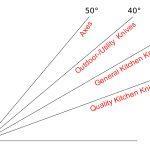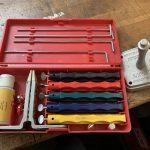I had a friend of mine over these days with two well-used and now dull knives – this inspired me to write this article. At a certain point of knife usage, just honing a blade’s edge won’t do the job anymore and you will have to re-sharpen your knife and give it a nice clean edge again.
This is how I do this with all my knives, kitchen or outdoor, in this case using a Lansky knife-sharpening-system (which I know is discussed controversially on the internet). With a little training and devotion you can achieve excellent results with it – and in a much easier way than with a traditional whetstone. This is my way to do it and it works absolutely satisfying for me.
The images below were taken when I was sharpening some kitchen knives. The process is the same for sharpening any other knife, except you will have to adjust the grinding angle and the grades of the grinding stones you will use.
 Prepare your Knife and mount it
Prepare your Knife and mount it
Clean your knife but don’t exaggerate this, a dirty knife will sharpen as well as a clean one (however, I’m an explicit fan of clean knives – just “because”, you know…) Mount your knife to the holding brackets, using the tightening screws. Mount it to the most exact middle of the blade that you can find.
Note that I have wrapped the brackets in one or two layers of masking tape for better grip and protection of the metal surface (“Pro Tip”).

 Set/Select Angle
Set/Select Angle
Depending on what kind of knife you’re working on, you’ll want to define a suitable sharpening angle for your edge (see the image on the left for a rough hint).
A small grinding angle makes a sharper but not so durable edge, a bigger angle will result in a slightly less sharp but more durable edge. Best, remember this angle for the future and do keep it for the whole sharpening process.
The angles on my set are:
17,5° | 20° (I use this for kitchen knives) | 25° (I use this for working knives) | 30°
And it has five grades of coarseness:
Very Coarse – For knives that have been heavily abused or that have never been sharpened before. Also for eliminating dents, etc.
Coarse – For heavily used knives that need an almost new edge
Medium – Starting point for normally used knives
Fine – For refining and finishing
Very Fine – For “polishing”

 Grind
Grind
Assemble a suitable grinding stone to one of the wire holders, paying attention to the stone surface and the wire being on the same level (use your desktop for reference) and tighten the screw. Begin sharpening.
The direction of your strokes is against the edge, thus when moving the stone you want to apply pressure when moving upwards. Except when using the “very coarse” stone you won’t need much more pressure than – let’s say – when you pet a dog on the head heartily. Rather do more strokes with less force than the other way round.
After some strokes on the whole length of the blade, carefully run your fingertip along the downside of the blade and try to feel a slight burr. This is what you want to achieve. As soon as you feel this slight burr over the full length of the blade, turn your knife over and, working as explained above, remove that burr, building a new one the other side now. Then swith to the next finer grade of stone.
So the concept is always to build that burr alternatingly on each side and then remove it with the next finer grit stone producing a new, but much finer one. Towards the end, when you use less and less pressure and ever finer grit, it will be very delicate. The last strokes should be so careful that no new burr can develop, only the remaining one is removed. Then you might polish the edge (see below) and even give it a few strokes on the strop (also see below).
 Do not:
Do not:
There’s always something that can go wrong, but the system I mention here is fairly foolproof. The only really annoying mistake you can make is when you accidentally run the end of the stone over your edge and hit it directly while pushing upwards again (see image to the left). This will most probably give you a notch and you’ll have to do extra work on that part again to buff it out. So better concentrate and pay attention to this.
 Polish
Polish
For working knives or for knives that don’t need ultimate sharpness and the most delicate edge, you can stop grinding after using the “fine” grit (see above) and have a decent result. But cooking knives for example sometimes demand for a little more effort. This is where the “very fine” grit comes in and gives the just sharpened edge some final care. Pay attention to not applying too much pressure here, but merely do a final “polish”.
 Strop
Strop
For delicate and very sharp edges you can finally run the knife over a leather strop (barbers do this all the time with their razors). This is the only time you do not work against the edge but with it. Run your knife over the leather a few times on each side, applying medium pressure. Try your best to keep the angle you used for grinding. Using a strop finally polishes the edge to a maximum, giving you ultimate sharpness.
I hope you liked this little tutorial. Leave me a comment with your thoughts on it if you like.

